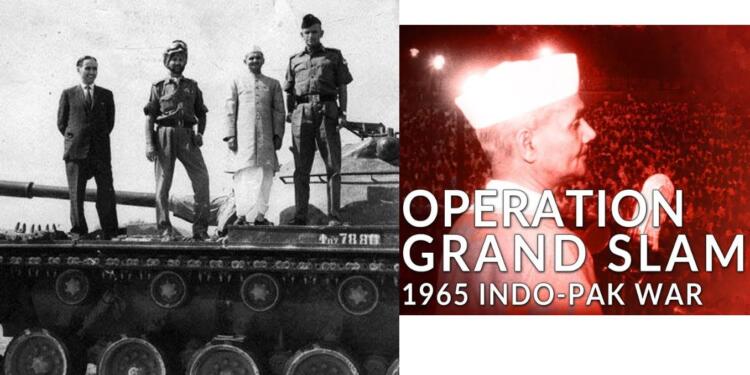Operation Grand Slam was one of the critical military operations undertaken by Pakistan on 1 September 1965 for capturing the strategic town of Akhnoor in the Jammu region. This was one of the offensives of the larger Indo-Pakistani War of 1965, fueled by the enduring territorial dispute over Kashmir, which dates back to the partition of British India in 1947.
Operation Gibralter, initiated by Pakistan, had been an unsuccessful operation, and the aim of this operation was to cut critical supply routes through which India maintained its control over Jammu and Kashmir. However, a combination of strategic mistakes, leadership shifts, and the rapid counter-response from India foiled the designs of Pakistan and ended up underscoring the nuances of regional geopolitics and military strategy in South Asia.
The Kashmir Conflict and Operation Gibraltar
The Indo-Pakistani War of 1965 was a direct result of the unresolved issues over Jammu and Kashmir, an area with a Muslim-majority population but governed by a Hindu king who had acceded to India in 1947. Pakistan and India had their first war over Kashmir shortly after that (1947-48), which was ended by a ceasefire line established at the time that became the Line of Control but did not resolve the issue of Kashmir. By 1965, tensions over Kashmir had heightened, and Pakistan launched “Operation Gibraltar”, an infiltration operation with the goal of instigating rebellion against Indian rule in the Kashmir Valley. Without local support, Operation Gibraltar failed, heightening India’s alertness and defensive posture in the area.
Objectives and Strategic Significance of Operation Grand Slam
With the failure of Operation Gibraltar, Pakistani military leaders came up with a more direct approach with “Operation Grand Slam”, which targeted Akhnoor. Strategically located at the edge of the Line of Control, Akhnoor remains the logistical lifeline between Jammu and Kashmir Valley in India. Pakistani intentions in taking over Akhnoor were to cut off a supply chain between India and isolate its forces in the valley from other parts of pushing it into negotiations discussing further claims over this region. Led first by General Akhtar Hussain Malik, Pakistan’s forces moved forward very fast; they captured Chamb-town that acted as a gateway to Akhnoor and moved forward. The policy of Pakistan’s operation was based on a swift operation where it broke the defenses of Indians before reinforcements would arrive.
Critical Moments and Tactical Shifts
Operation Grand Slam had an early promising phase for Pakistan and witnessed sizeable advances into Indian territory. However, the operation received a serious jolt when Pakistani leadership replaced General Malik with General Yahya Khan without any prior intimation. The reasons for this decision are still not clear; some attribute it to political factors within Pakistan’s leadership, while others believe it was an attempt to prevent escalation that might draw international intervention. In any case, the change of command resulted in one-day delay, which helped India to mobilize and harden defenses in Akhnoor, which actually turned out to be the watershed in the operation.
Indian Response: Quick Response and Strategic Diversion
Indian response to Operation Grand Slam was quick and multilayered. Indian forces swiftly brought in reinforcement in the Akhnoor sector, but most importantly, the 191st Infantry Brigade was a crucial factor in the blunting of the Pakistani advance. Further, India launched a counter-offensive on September 6 by crossing the international border in Punjab towards Lahore. This was an unexpected move that not only diverted Pakistani resources away from Akhnoor but also opened a new front that stretched Pakistan’s military capabilities thin.
The decisive blow that ended the Pakistani force advance was the strategic implementation of an integrated air and ground attack by India. The Pakistani forces were given a blow, and supply lines were pounded through well-coordinated airstrikes targeting their lines. This blow would deny them logistical support and consequently reduce the number of effective operational Pakistani soldiers. Diversionary attacks, reinforcement, and superior air support kept Pakistan on the back foot, forcing the operation to its end.
Tactical and Strategic Consequences of the Success of Operation Grand Slam
Operation Grand Slam, though full of promise at the outset, is often considered an opportunity missed by Pakistan. It did reflect the potential as well as the pitfalls of bold military strategies in Kashmir’s rugged terrain. Delay in Pakistani command disrupted operational cohesion and exposed the campaign to India’s countermeasures. From the Indian side of view, Operation Grand Slam led to underlining their weaker links along its logistical arteries with Jammu and Kashmir. As a natural offshoot, there were afterwar developments in Akhnoor and other equally sensitive bypasses over Tawi.
The political-diplomatic fallout of the campaign were immense. This generated a media storm around the world as the United Nations negotiated an agreement for both countries on September 22 to end the fighting. The Soviet Union brokered and signed the Tashkent Agreement that mandated both parties to retreat to prewar lines, not to discuss the cause of their war, which was Kashmir. India and Pakistan refused to swap major pieces of territory on the ground; however, the Kashmir issue remained controversial and ensured that there would be further armed conflicts in the future.

The significance of Akhnoor is not just in Operation Grand Slam; it is a strategic asset because of the location, its logistical importance, and symbolic value in the India-Pakistan conflict. It would give Pakistan direct access to the main roads leading into Jammu and Kashmir, which could cut off Indian forces in the Kashmir Valley and be a jump-off point for further raids. For Pakistan, taking Akhnoor will enhance its military posture but more as a symbolic victory which reflects that it is quite strong enough to contest India’s domination in the area.
Strategic Recommendations for Attaining Akhnoor
India has strengthened defenses at this place as well due to the strategic significance which it still holds. In addition, recommendations for the strong Indian position in Akhnoor would be:
Sophisticated Surveillance: Implement state-of-the-art technologies in the form of drones, radar, and satellite images to track the movement on the ground near the LoC and act before there is an incursion.
Hardened Infrastructure: Harden the defensive points with anti-tank fortifications, bunkers, and secure supply lines to ensure that Akhnoor retains its stronghold status and speedy mobilization is possible in any given threat.
Deployment of further reinforcements: The supplementary armor divisions and QRTs would thus enable quick suppression and elimination of hostile activity, giving an impressive defense structure.
Community Relations: There must be strong relationships with local communities surrounding Akhnoor to develop a solid support network. Locals may be mobilized to raise alarms in cases of suspected activities and means can be provided for evacuation during escalation and this will stabilize the regions.
Diplomatic Efforts: Maintaining diplomatic contacts with the adjacent countries but yet being vigilante would inevitably result in a more viable and long run approach for winning Jammu and Kashmir.
In Operation Grand Slam, there has been depicted really the nature of playing with very high stakes and with intricacy along with that in strategic calculation through the involvement in the problem of conflict over Kashmir through Indo-Pakistani wrangle. Even though it had enjoyed an initial triumph at it was able to expose few flaws in Indian defensive architecture, the quicker mobilization of Indian forces coupled with tactical counter strategies and good air cover put in place successfully curtailed the forward push of Pak Army.
This operation failure proved that India required more concrete commitment towards its logical networks and also influenced the following defense strategies that were based on the time-and-once-again importance of preparing strategically and under single, robust command in uncertain borderline lands.
Even today, more than three decades after the drama of Operation Grand Slam, Akhnoor still assumes a strategic value as one potential point of weakness and advantage in the whole battle of control over Kashmir. Indian and Pakistani managements will continue to carry out a delicate balancing act across the contested political stratum, even though the lesson from the events of Operation Grand Slam remain a potent reminder, pointing strongly towards quick mobilization of troops, agile tactics of operation, and the defense position.































